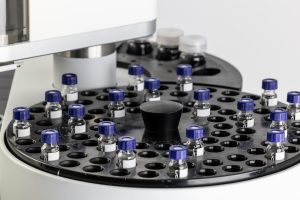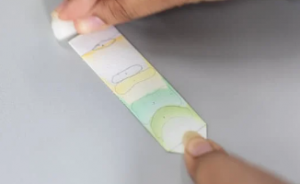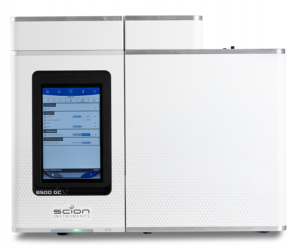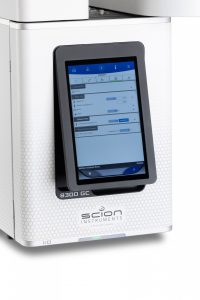Gas Chromatography – Definition, Uses, Advantages & More
What is Gas Chromatography?
Chromatography is an analytical technique used to separate the components, or solutes, within a mixture. First, the mixture gets dissolved in or mixed with a mobile phase (gas or liquid), which is a going to move or flow through the system. This mobile phase carries the mixture through to a second substance, the stationary phase which can be highly customised to optimise the separation. As the mixture progresses, its components disperse and separate at varying speeds depending on their interaction with the stationary phase and mobile phase.
How Does Gas Chromatography Work?
Gas chromatography involves several steps:
- Sample Preparation: the initial step involves preparing samples by dissolving or diluting them in a solvent
- Sample Introduction: the prepared sample is introduced into the gas chromatograph via syringe or autosampler, injecting it into the inlet port
- Vaporization: if the sample is in liquid form, it undergoes vaporization within the hot inlet, transforming it into a gas phase for analysis
- Separation: an inert gas carries the sample through the column. Substances interact differently with the columns stationary phase and travel at different speeds, causing them to separate based on their chemistry.
- Detection: the separated compounds exit the columns and enter a detector.
- Chromatogram Generation: the gas chromatograph produces a chromatogram, displaying peaks that represent the different components in the sample. Peak size indicates the signal reaching the detector often relating to the quantity, while the number and position of peaks reveal the different compounds in the sample and their respective retention times.

Regarding the choice of inert gases for the mobile phase, helium and nitrogen are commonly used. However, due to the rising costs and supply challenges with helium, hydrogen is now a popular cheaper alternative. With similar chromatographic characteristics to helium, many labs are switching to hydrogen.
For a more detailed exploration of carrier gases and their differing impacts on results, refer to the following application note: ‘The Use of Alternative Carrier Gases in Gas Chromatography’.
Uses of Gas Chromatography
Gas Chromatography has multiple used in a wide range of fields:
- Biochemical research:
- Used to separate and identify the chemical components in biological samples
- Petroleum Industry
- Used to analyse the intricate mixtures of hydrocarbons present in petroleum.
- Forensic Science
- Used to test sample collected from crime scenes.
- Pollution Monitoring
- Used to detect contaminants and unknown pollutants in air and water samples.
- Bioanalytic
- Used for the quality control of drugs.
- Chemistry
- Used to study the individual components within a chemical mixture, such as the purity of reaction products to facilitate a deeper understanding of the reaction process and how it can be optimised.
Explore some of the many uses of Gas Chromatography in our article: ‘Gas Chromatography Applications’.
The History of Chromatography
The credit for the discovery of chromatography is commonly attributed to Russian botanist Mikhail S. Tsvet, who in 1901 detected the physio chemical foundations of separation.2 He systematically applied this understanding to the separation of plant pigments, specifically targeting chlorophylls and carotenoids.

Initially, it is believed that chromatography found use among artists, colour theorists, and artisans striving to refine industrial textile dyes. 3 By harnessing the principles of this technique, chemists in the mid-20th century pioneered the development of modern chromatographic processes, effectively separating the chemical components within mixtures. Today, scientists employ four key types of chromatography: gas chromatography, high-performance liquid chromatography, paper chromatography, and thin-layer chromatography.
What is a Chromatogram?
A chromatogram refers to the electronic file or physical printout that showcases the results of a chromatography procedure in a graphical format (with a detector signal plotted against the time at which it was collected), covering the information produced during the run.
Types of Chromatography
Today, chromatography comprises of four types: liquid, gas, paper and thin layer.
- Gas Chromatography (GC)
- Find out more about gas chromatography here.
- High Performance Liquid Chromatography (HPLC)
- Find out more about HPLC here.
- Paper Chromatography
- Considered one of the most basic types of chromatography methods, paper chromatography is often used when studying mixtures pigments. As evident from this name the stationary phase and separation in this method takes place on a sheet of paper.
- Thin-Layer Chromatography
- Thin layer chromatography is performed on a thin glass plate lined with gel.
Advantages of Gas Chromatography
Gas chromatography offers the obvious advantage of enabling the identification of unknown substances within compounds, allowing for a deeper understanding of their properties. However, some further benefits include:
- Versatility – GC offers various measurement methods for a broad range of compounds, allowing its application to be used across various fields
- Robustness – its robustness contributes to its reliability and consistency
- Complementarity With Other Techniques – GC seamlessly integrates with other methods, such as mass spectrometry, expanding its utility and application possibilities
- Reliability – GC results are highly reliable and easily reproducible
- Rapid Analysis – The GC process delivers quick results, often within minutes
- Diverse Sample Analysis – GC accommodates the analysis of liquid, gas, and dissolved solid samples, offering versatility not commonly found in alternative methods
- Sensitive Detection – Equipped with various detectors like FID and NPD, gas chromatography provides highly sensitive detection for specific compounds, enhancing its analytical capability
Gas Chromatography Range from SCION
Our GC solutions are designed with are crafted with a focus on precision, speed, and reliability to redefine the standards of analytical excellence. Tailored for a wide array of applications ranging from quality control to scientific research, these solutions enable you to explore new frontiers in your research efforts and accelerate progress.

The 8300 and 8500 GC models combine cutting-edge technology, user-friendly features, and exceptional versatility. Their robust build, along with sophisticated software integration, ensures smooth operation and precise outcomes, even when handling the most challenging analytical tasks.
Find out more about our GC systems.
References
- https://www.chromatographytoday.com/news/gc-mdgc/32/breaking-news/why-is-chromatography-called-chromatography/31178
- http://scihi.org/mikhail-tsvet-chromatography/#:~:text=The%20Invention%20of%20Cromatography&text=%5B2%5D%20Mikhail%20Tsvet%20invented%20chromatography,ether%20as%20the%20mobile%20phase.
- https://www.chromatographytoday.com/news/hplc-uhplc/31/breaking-news/uncovering-artrsquos-mysteries-with-chromatography/33105

